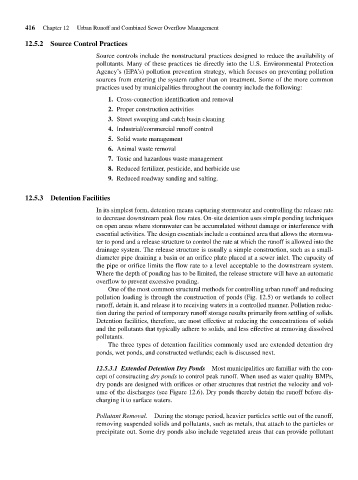Page 458 - Fair, Geyer, and Okun's Water and wastewater engineering : water supply and wastewater removal
P. 458
JWCL344_ch12_398-456.qxd 8/4/10 9:37 PM Page 416
416 Chapter 12 Urban Runoff and Combined Sewer Overflow Management
12.5.2 Source Control Practices
Source controls include the nonstructural practices designed to reduce the availability of
pollutants. Many of these practices tie directly into the U.S. Environmental Protection
Agency’s (EPA’s) pollution prevention strategy, which focuses on preventing pollution
sources from entering the system rather than on treatment. Some of the more common
practices used by municipalities throughout the country include the following:
1. Cross-connection identification and removal
2. Proper construction activities
3. Street sweeping and catch basin cleaning
4. Industrial/commercial runoff control
5. Solid waste management
6. Animal waste removal
7. Toxic and hazardous waste management
8. Reduced fertilizer, pesticide, and herbicide use
9. Reduced roadway sanding and salting.
12.5.3 Detention Facilities
In its simplest form, detention means capturing stormwater and controlling the release rate
to decrease downstream peak flow rates. On-site detention uses simple ponding techniques
on open areas where stormwater can be accumulated without damage or interference with
essential activities. The design essentials include a contained area that allows the stormwa-
ter to pond and a release structure to control the rate at which the runoff is allowed into the
drainage system. The release structure is usually a simple construction, such as a small-
diameter pipe draining a basin or an orifice plate placed at a sewer inlet. The capacity of
the pipe or orifice limits the flow rate to a level acceptable to the downstream system.
Where the depth of ponding has to be limited, the release structure will have an automatic
overflow to prevent excessive ponding.
One of the most common structural methods for controlling urban runoff and reducing
pollution loading is through the construction of ponds (Fig. 12.5) or wetlands to collect
runoff, detain it, and release it to receiving waters in a controlled manner. Pollution reduc-
tion during the period of temporary runoff storage results primarily from settling of solids.
Detention facilities, therefore, are most effective at reducing the concentrations of solids
and the pollutants that typically adhere to solids, and less effective at removing dissolved
pollutants.
The three types of detention facilities commonly used are extended detention dry
ponds, wet ponds, and constructed wetlands; each is discussed next.
12.5.3.1 Extended Detention Dry Ponds Most municipalities are familiar with the con-
cept of constructing dry ponds to control peak runoff. When used as water quality BMPs,
dry ponds are designed with orifices or other structures that restrict the velocity and vol-
ume of the discharges (see Figure 12.6). Dry ponds thereby detain the runoff before dis-
charging it to surface waters.
Pollutant Removal. During the storage period, heavier particles settle out of the runoff,
removing suspended solids and pollutants, such as metals, that attach to the particles or
precipitate out. Some dry ponds also include vegetated areas that can provide pollutant

